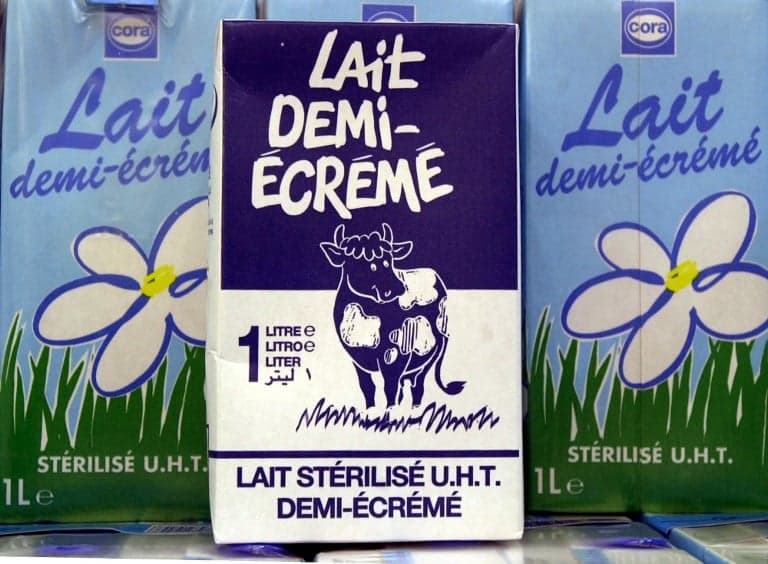Decoding the French: Why do they have such a thirst for UHT milk?

Despite being a country known for its culinary endeavours, France -- like other mainland European countries -- prefers long-life UHT milk to fresh. So, what's behind this gastronomic misnomer?
It’s easy to understand why many foreigners in France find it rather strange that long-life milk is so prevalent in French supermarkets.
France is after all a country that’s known for putting taste before pretty much anything when it comes to food, so why favour a type of milk that’s generally less delicious and refreshing than the fresh stuff?
According to varied sources ranging from leblogdulait.fr (themilkblog.fr) and The Times, anywhere between 90 and 97 percent of milk sold in France is UHT.
That’s an awful lot of long-life liquid, especially when considering that France is Europe’s second largest producer of milk after Germany (French cows produce a whopping 780 litres of milk every second).
READ ALSO:
 Photo: AFP
Photo: AFP
So what does UHT stand for and why are the French so partial to it?
UHT milk gets its name from the ultra-high temperature process it goes through to be sterilized, giving it a shelf life of up to nine months, without even having to be refrigerated before it’s been opened.
UHT is in fact a more advanced form of pasteurisation, invented at Lille University in the 1880s by acclaimed French scientist Louis Pasteur.
His research also served to remove unwanted, ageing organisms from Gallic food favourites wine and cheese, so it seems understandable that France, as the first nation to reap the benefits of pasteurisation, would stick by the process.
The fact that the French have a somewhat proven reputation for having higher levels of hypochondria than other countries could also explain why milk that’s been sterilised of all germs is still the most sought-after (even though fresh milk is also pasteurised nowadays).
For the most part however it seems to be down to preference and tradition.
France after all isn’t the only country on the continent to choose long-life milk over fresh.
Belgium and Spain favour UHT overwhelmingly whereas in Greece and Finland it accounts for just one and two percent of milk sales respectively. In Britain, long-life milk consumption stands at around 8.4 percent and in the US UHT milk has never really taken off either.
For some nations, fresh milk is far more refreshing and tasty and the concept of storing it a cardboard box at room temperature - let alone drinking it warm - is bizarre, unsavoury and potentially risky.
For others, the watered down richness of milk that’s UHT is the only ‘milk taste’ they know, and its durability is more practical than the less readily available fresh produce.
If some outside commentators still find the French love of long-life milk a culinary misnomer, with a global shift towards UHT milk, they may have to start getting used to it.
Comments (3)
See Also
It’s easy to understand why many foreigners in France find it rather strange that long-life milk is so prevalent in French supermarkets.
France is after all a country that’s known for putting taste before pretty much anything when it comes to food, so why favour a type of milk that’s generally less delicious and refreshing than the fresh stuff?
According to varied sources ranging from leblogdulait.fr (themilkblog.fr) and The Times, anywhere between 90 and 97 percent of milk sold in France is UHT.
That’s an awful lot of long-life liquid, especially when considering that France is Europe’s second largest producer of milk after Germany (French cows produce a whopping 780 litres of milk every second).
READ ALSO:
 Photo: AFP
Photo: AFP
So what does UHT stand for and why are the French so partial to it?
UHT milk gets its name from the ultra-high temperature process it goes through to be sterilized, giving it a shelf life of up to nine months, without even having to be refrigerated before it’s been opened.
UHT is in fact a more advanced form of pasteurisation, invented at Lille University in the 1880s by acclaimed French scientist Louis Pasteur.
His research also served to remove unwanted, ageing organisms from Gallic food favourites wine and cheese, so it seems understandable that France, as the first nation to reap the benefits of pasteurisation, would stick by the process.
The fact that the French have a somewhat proven reputation for having higher levels of hypochondria than other countries could also explain why milk that’s been sterilised of all germs is still the most sought-after (even though fresh milk is also pasteurised nowadays).
For the most part however it seems to be down to preference and tradition.
France after all isn’t the only country on the continent to choose long-life milk over fresh.
Belgium and Spain favour UHT overwhelmingly whereas in Greece and Finland it accounts for just one and two percent of milk sales respectively. In Britain, long-life milk consumption stands at around 8.4 percent and in the US UHT milk has never really taken off either.
For some nations, fresh milk is far more refreshing and tasty and the concept of storing it a cardboard box at room temperature - let alone drinking it warm - is bizarre, unsavoury and potentially risky.
For others, the watered down richness of milk that’s UHT is the only ‘milk taste’ they know, and its durability is more practical than the less readily available fresh produce.
If some outside commentators still find the French love of long-life milk a culinary misnomer, with a global shift towards UHT milk, they may have to start getting used to it.
Join the conversation in our comments section below. Share your own views and experience and if you have a question or suggestion for our journalists then email us at [email protected].
Please keep comments civil, constructive and on topic – and make sure to read our terms of use before getting involved.
Please log in here to leave a comment.